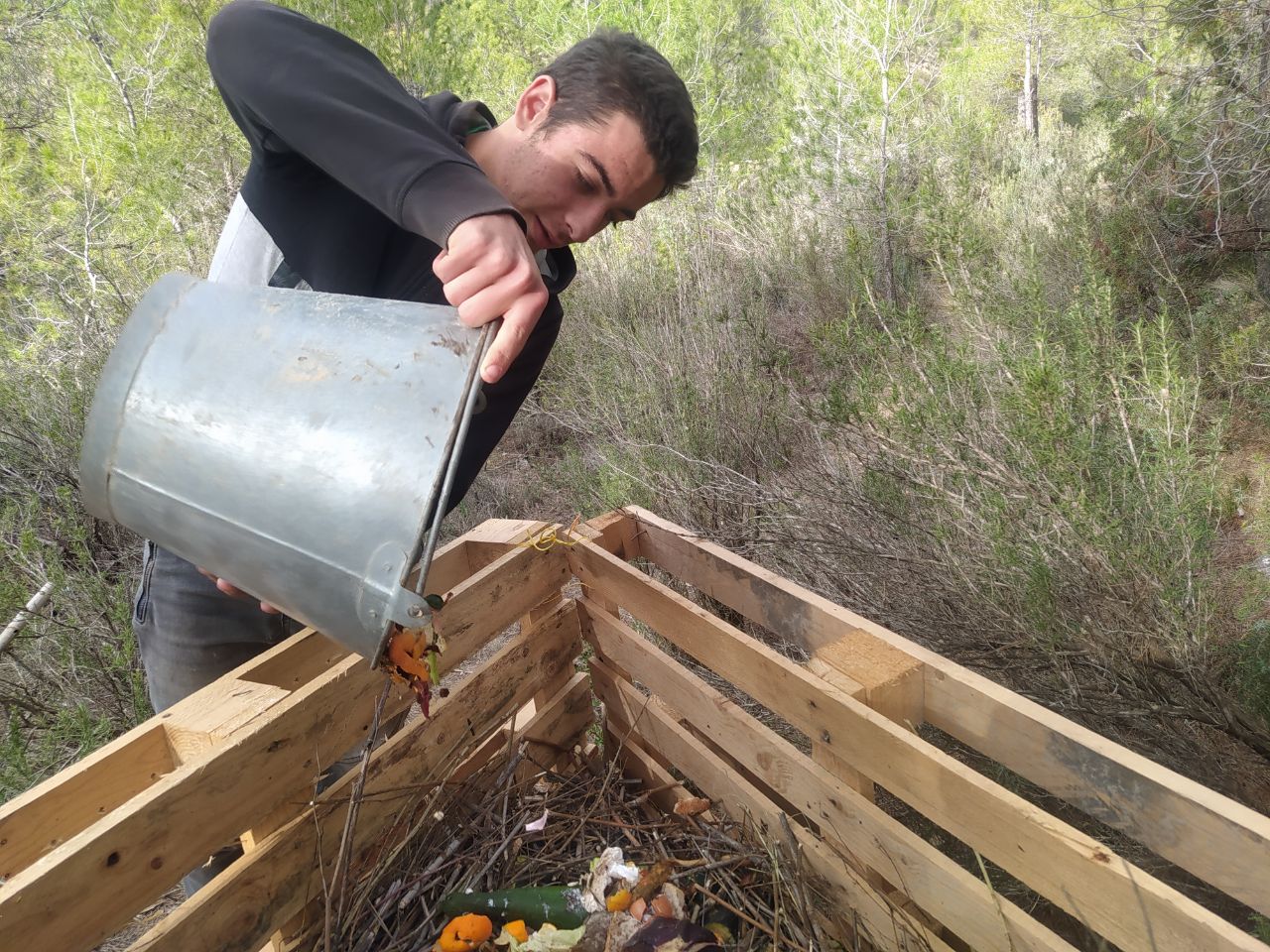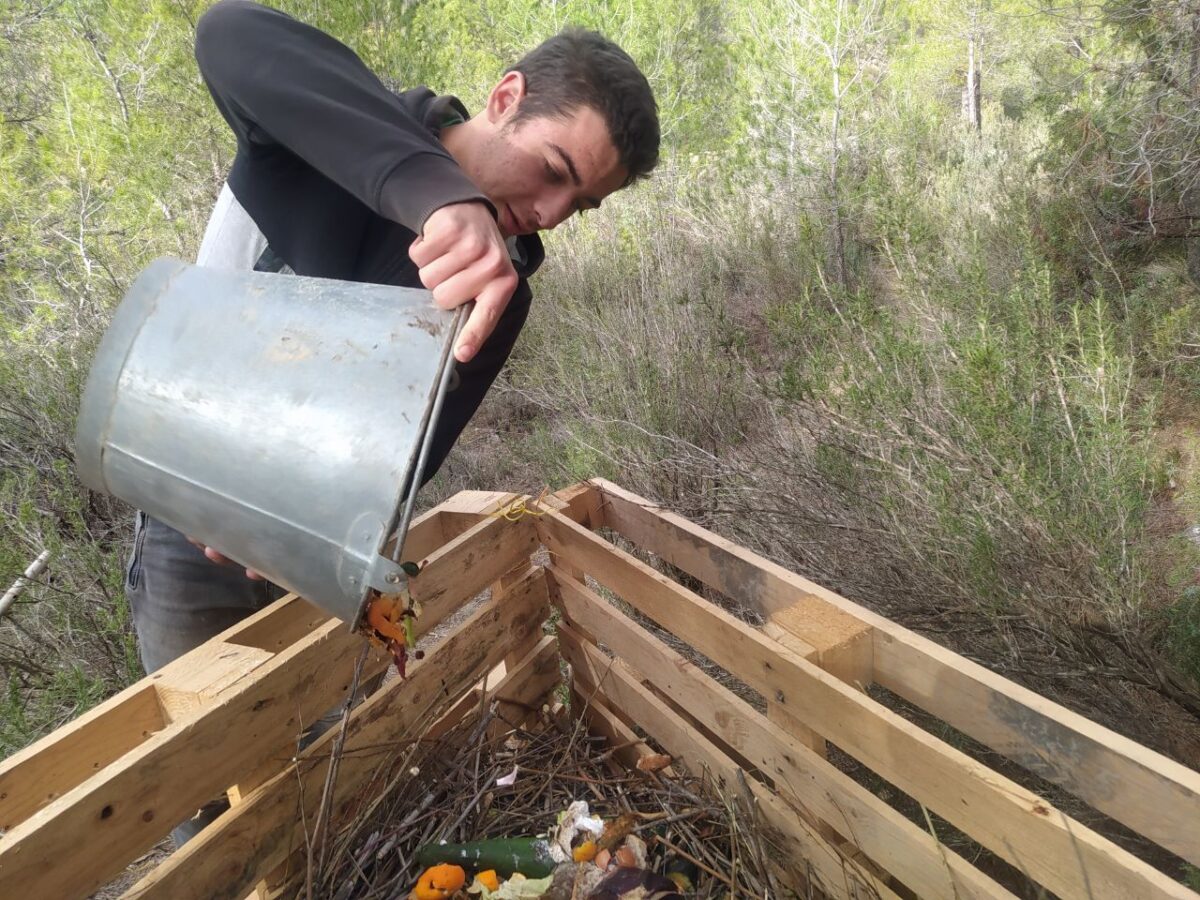
My composting journey
Hi, I am Gaius, and I will tell you about my time at Boodaville and the compost bins I made.
It’s been a great three months that I got to spend here in Boodaville. Everything revolved around our community here, which was great. Everyone was so kind, and we all worked together very well. In my first month here, I learned how to take part in this community. The various practices of Boodaville, like the morning circle, where we get together and discuss how we are and what our day will look like, and another practice that I had to get used to was the concept of cooking with what you have instead of with what the shop has. Then, in my second month, I was busy with my own things. My mother came here, and I got to show her this place. And I had the ESC training, where I met loads of interesting people who were also doing an ESC job. In this month, I also made a bird house. Then my third month was focused on the theme of the tree planting event. We had a very big event in which we were going to plant 1500 trees, and I was part of the team that got to organize the experience.
Apart from all these great community experiences, I also wanted to do something on my own.
I wanted to leave my special stamp on Boodaville. A bit of my personal touch. Boodaville is an interesting project because so many people are involved with it. Every year, new people come and go, so this place is a combination of all the different personalities and cultures of the people who spend time here. I also wanted to make something that would be useful to the project in the long term. Because people don’t stay for a long time, sometimes a project you have can be neglected after you leave. Because other people could see it as less important to finish or don’t know what to do with it. Some people had started making a compost pile, but nobody regulated it after they left. Perhaps because they did not know of its existence. And other people might have wanted to start a pile, but they did not know how to make one. So a project that I think will help Boodaville out a lot is to make a clear plan for compost. It will definitely be useful because compost is always very important in the garden. And if there is a clear plan and location for compost, people will also continue making compost after I leave.
Compost is one of the most important things in a permaculture garden.
In simple terms, some compost in the ground will make sure that plants are able to grow better because it allows the microorganisms in the compost to spread to the rest of the land. And there are also a lot of good nutrients for plants in compost. Therefore, a nice rule of thumb is that when planting anything, put some compost in the ground to help it grow. Compost is made by throwing some organic material in a pile and letting it be processed by microorganisms. What is also very nice is that it is made from materials that are considered to be waste by many other people.
For making compost, a few things are important to make the process go well.
I like to explain how to make it with the elements:
- First of all, the pile should consist of only small pieces. That means no big logs of wood. Just little sticks. This is mostly because a larger surface area means that the reaction goes quicker. Also, the microorganisms can spread more easily; additionally, big chunks take way too long, and it insulates the heat a bit better.
- Earth. The pile should consist of a good balance between carbon and nitrogen. Carbon is represented by wood and straw, and nitrogen is represented by kitchen scraps and manure. This balance is important to make the composting go faster. This site explains it in more detail: https://www.lowimpact.org/posts/composting-explaining-the-carbon-nitrogen-ratio
- Fire. The reaction to composting works better when it is warmer. Which works out well because composting in itself releases heat. This means that the composting needs some time to start up. But after a while, you should feel some heat when next to the pile. It can reach temperatures of up to 60 degrees C
- Water. The process works a lot better if there is water in the pile. This is why it is important in hot and dry climates like Spain to cover the pile so the water does not evaporate. But it is also nice to take the cover off during rainy times so the water can get in.
- Wind. The reaction to composting needs oxygen. This is why it is very important that the pile get enough air. Especially the center of the pile.
Also, it is important to start off with microorganisms already in your pile, so if you already have some, you can add some finished compost to the pile at the start.
My process for making the bins was based on what would work well, but it also needed to be easy and adaptable. I decided to use pallets to make the bin. It makes the process of making a bin a lot simpler, and we recycle used products. You simply put four, or three in this case, pallets next to each other and combine them, and then you have a big box where you can put your stuff. I had used this technique before, and it works very well in keeping everything in a pile while still letting through air, and they are plenty resistant to the elements. The question of where to put the bin was also important. I chose to put it close to the house because important things should be closer to where you live and your zone. And we also need to bring things there from our kitchen scraps. Another important thing is for new people to know when the pile was made, so they know in what state the pile is and when it is done. So I drilled 12 holes in each bin, and we can put a screw in the subsequent hole where the pile was made. Additionally, for the people coming to Boodaville, I made a document that explains the intricacies of making compost so they can continue making compost after I have left. Finally, I made my own pile of compost in the bins, mostly using the kitchen scraps from the tree planting event.
Now that my time at Boodaville is almost finished, I am left wondering what my eventual impact on Boodaville will be. Will the trees I planted still stand in ten years, will the compost bins be filled after I leave, and will a bird at some point inhabit my bird house? I don’t know. But what I don’t know is that there are things that will always stick with me. The things I learned and the memories I made here will be with me forever.
So thank you, Boodaville.


